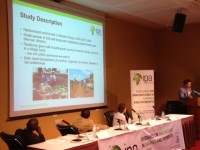The
Evidence on Innovations in Savings and Payments conference kicked off in Kampala, Uganda yesterday. Over the course of two days, researchers showcased results from recent evaluations in Africa on child and youth savings, the impact of reducing cost barriers to saving among the poor, behavioral impediments to saving, using mobile phones for behavioral change, and the adoption and impact of mobile money.
Day one started with three IPA evaluations on child and youth savings, two from Uganda presented by Yale University’s
Dean Karlan, and a related study from Ghana presented by
James Berry of Cornell University. The presentations discussed the results from evaluating the impact of providing access to savings and financial education for primary school children and youth. Results from the Ghana study were previously discussed in a blog post
here.
In the study with
out-of-school youth in Uganda, the financial education program was found to improve financial knowledge and savings behaviors, and increase income. The
evaluation of financial and social education on school children in Ghana found positive impacts on savings behavior but not financial knowledge. In the
third evaluation, access to a savings facility at school for primary school children in Uganda led to improvements in investment in education supplies and test scores. These represent some of earliest findings from programs which aim to promote sound savings habits among young people. Particularly because of inconclusive evidence thus far about the impact of providing financial education to adults, these positive findings about the value of providing financial education and access to savings to children at an early age are encouraging.
Access to and usage of savings services among adults was discussed in the two afternoon sessions. The first examined the effects of reducing cost barriers to saving, either by
increasing access to formal savings, or by
reducing transaction costs, while the second session looked at the effects of reducing behavioral barriers to saving. In the session on behavioral barriers, one of the studies (presented by
Jessica Goldberg of the University of Maryland) discussed the impact of providing tobacco farmers in Malawi with
access to commitment savings accounts. Farmers who were offered a commitment savings account increased land sown, agricultural input usage, and crop sales.
One theme common across all sessions was the importance of uncovering the specific channels through which change occurs; for instance,
Simone Schaner’s
study in Kenya uncovered the role played by intra-household bargaining power in how providing ATM cards to savings account holders changed their behavior. Women with low bargaining power in the household did not see improved usage of their bank accounts when provided with easier and cheaper access to them via ATM cards. However, for both joint accounts and accounts owned by men, reducing transaction costs led to improved usage and balances in their savings accounts.
You can find a wrap-up of Day 2
here, and for more information about all the other exciting research presented at the conference, do check out the
conference agenda (PDF) and follow our
Twitter stream.

